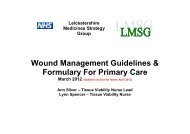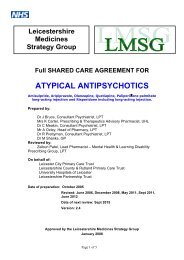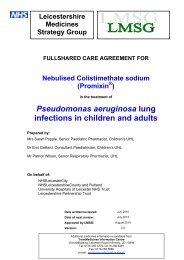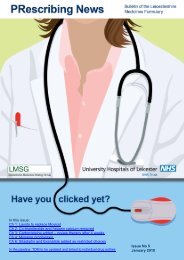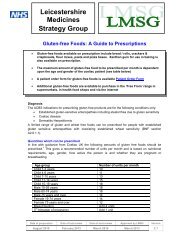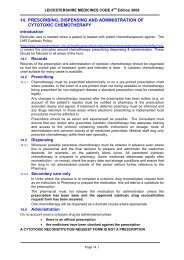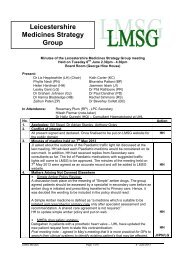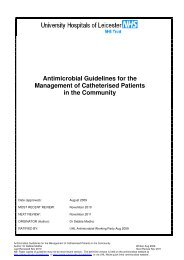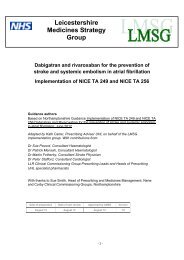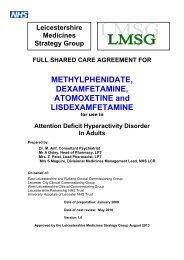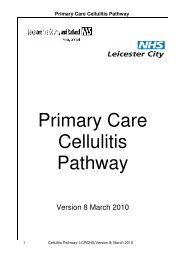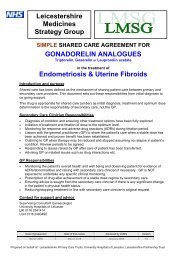Nebulised Colomycin Pseudomonas aeruginosa lung infections in ...
Nebulised Colomycin Pseudomonas aeruginosa lung infections in ...
Nebulised Colomycin Pseudomonas aeruginosa lung infections in ...
You also want an ePaper? Increase the reach of your titles
YUMPU automatically turns print PDFs into web optimized ePapers that Google loves.
Shared Care Policy for the prescrib<strong>in</strong>g of <strong>Nebulised</strong> <strong>Colomyc<strong>in</strong></strong> <strong>in</strong> thetreatment of <strong>Pseudomonas</strong> <strong>aerug<strong>in</strong>osa</strong> <strong>lung</strong> <strong><strong>in</strong>fections</strong> <strong>in</strong> Adult patientswith cystic fibrosis and bronchiectasisIntroduction and purposeShared care has been def<strong>in</strong>ed as the mechanism of shar<strong>in</strong>g patient carebetween primary and secondary care providers. This document sets out theseresponsibilities from <strong>in</strong>itial diagnosis to on go<strong>in</strong>g support.Background<strong>Pseudomonas</strong> <strong>aerug<strong>in</strong>osa</strong> is a pathogen that causes severe <strong>lung</strong> damage <strong>in</strong>patients who become colonised and then chronically <strong>in</strong>fected. Patients withCystic Fibrosis and Bronchiectasis are at risk of significant morbidity andmortality from the damage caused by this pathogen. <strong>Nebulised</strong>antipseudomonal antibiotic treatment has been shown to improve <strong>lung</strong>function, slow the rate of respiratory decl<strong>in</strong>e and reduce the frequency ofexacerbations of <strong>in</strong>fection <strong>in</strong> these patients. <strong>Nebulised</strong> antibiotics are able toachieve high local concentrations with low systemic absorption and toxicity asopposed to <strong>in</strong>travenous antibiotics, where there is high risk of develop<strong>in</strong>gadverse effects from systemic absorption.Drug covered by the policy and it’s place <strong>in</strong> treatment<strong>Colomyc<strong>in</strong></strong> is only licensed for the treatment by <strong>in</strong>halation of <strong>Pseudomonas</strong><strong>aerug<strong>in</strong>osa</strong> <strong>lung</strong> <strong><strong>in</strong>fections</strong> <strong>in</strong> patients with cystic fibrosis (CF). It is alsolicensed for <strong>in</strong>travenous adm<strong>in</strong>istration of the treatment of some serious<strong><strong>in</strong>fections</strong>, caused by gram negative bacteria.This Shared Care Agreement only refers to the treatment of <strong>Pseudomonas</strong><strong>aerug<strong>in</strong>osa</strong> <strong>lung</strong> <strong><strong>in</strong>fections</strong> for treatment by INHALATION. It also covers theuse of <strong>in</strong>haled colomyc<strong>in</strong> for the treatment of <strong>in</strong>fection <strong>in</strong> patients withBronchiectasis (this is an unlicensed <strong>in</strong>dication but common practice with<strong>in</strong>the hospital)<strong>Colomyc<strong>in</strong></strong>. The licensed dose for the treatment by <strong>in</strong>halation <strong>in</strong> patients withcystic fibrosis is 2 mega units (2,000,000 units) twice daily.The usual dose prescribed for treatment by <strong>in</strong>halation for patients withBronchiectasis is 1 mega unit (1,000,000 units) twice dailyPage 2 of 5
Secondary Care Cl<strong>in</strong>ician Responsibilities• Diagnosis of pseudomonas <strong>aerug<strong>in</strong>osa</strong> <strong>in</strong>fection <strong>in</strong> either CF patients orBronchiectasis patients based on a timely and comprehensiveassessment.• Initiation of prescription of colomyc<strong>in</strong> and ensure the first test dose iscarried out before a cont<strong>in</strong>uous prescription is supplied• Supply<strong>in</strong>g the <strong>in</strong>itial 28 days treatment• Provision of nebuliser system, and tra<strong>in</strong><strong>in</strong>g of patient/carer <strong>in</strong> the use of thenebuliser system• Monitor<strong>in</strong>g for response and adverse drug reactions (ADRs) dur<strong>in</strong>g the firsttest dose and the <strong>in</strong>itiation period• Liaison with the general practitioner (GP) to share the patient’s care whenthe test dose has been carried out and proven benefit has beenestablished• Outl<strong>in</strong><strong>in</strong>g to GP when therapy may be stopped assum<strong>in</strong>g no improvementis recognised <strong>in</strong> the patient’s condition. Suggest a review of patientscondition and efficacy of treatment 6 months after discharge fromsecondary care, and then annually thereafter, with consideration at eachreview as to whether treatment needs to cont<strong>in</strong>ue.• Evaluat<strong>in</strong>g ADRs raised by the GP and evaluat<strong>in</strong>g any concerns aris<strong>in</strong>gfrom physical checks & reviews undertaken by GP.• Advis<strong>in</strong>g GP on related issues such as drug <strong>in</strong>teractions etc.• Advis<strong>in</strong>g the GP on supply issues related to the prescrib<strong>in</strong>g of nebulisedcolomyc<strong>in</strong>GP Responsibilities• Monitor<strong>in</strong>g the patient’s overall health and well be<strong>in</strong>g• Observ<strong>in</strong>g patient for evidence of ADRs or any abnormalities and rais<strong>in</strong>gwith secondary care cl<strong>in</strong>ician if necessary• Prescription of colomyc<strong>in</strong> after achievement of a stable dose regime bysecondary care• Ensur<strong>in</strong>g advice is sought from the secondary care cl<strong>in</strong>ician if there is anysignificant change <strong>in</strong> the patient’s physical health status• Reduc<strong>in</strong>g and stopp<strong>in</strong>g treatment <strong>in</strong> l<strong>in</strong>e with secondary care cl<strong>in</strong>iciansorig<strong>in</strong>al requestContact for support and adviceConsultant Respiratory PharmacistAnna MurphyBronchiectasis Specialist NurseKaren PayneCystic Fibrosis Specialist NurseBerni DonaghyConsultant Respiratory PhysiciansDr S Range Prof I Pavord Dr M Ste<strong>in</strong>erProf P Bradd<strong>in</strong>g Prof A Wardlaw Dr N KhanDr R Green Dr G Woltmann Dr C Brightl<strong>in</strong>gDr J Bennett Dr M Morgan Dr S AgarwalDr M PeakePage 3 of 5
Support<strong>in</strong>g <strong>in</strong>formationIndications for Therapy and Dosage<strong>Nebulised</strong> Colist<strong>in</strong> (<strong>Colomyc<strong>in</strong></strong>®) is <strong>in</strong>dicated for chronic pulmonary <strong>Pseudomonas</strong> Aerug<strong>in</strong>osa<strong>in</strong>fection <strong>in</strong> Cystic fibrosis patients and patients diagnosed with bronchiectasis. It is also<strong>in</strong>dicated for eradication of first pulmonary colonisation with <strong>Pseudomonas</strong> Aerug<strong>in</strong>osa for aperiod of three weeks – three months (<strong>in</strong>itially with high dose ciprofloxac<strong>in</strong>)Cystic Fibrosis Patients <strong>Colomyc<strong>in</strong></strong> 2 million units nebulised twice daily for three months(Eradication)Ciprofloxac<strong>in</strong> 750mg twice daily is co-adm<strong>in</strong>isteredBronchiectais Patients <strong>Colomyc<strong>in</strong></strong> 1 million units nebulised twice daily for three months(Eradication)Ciprofloxac<strong>in</strong> 750mg twice daily is co-adm<strong>in</strong>isteredCystic Fibrosis patients – prophylaxis – <strong>Colomyc<strong>in</strong></strong> 2 million units nebulised twice dailyBronchiectass patients – prophylaxis – <strong>Colomyc<strong>in</strong></strong> 1 million units nebulised twice dailyContra-<strong>in</strong>dications, Precautions and Warn<strong>in</strong>gs• <strong>Colomyc<strong>in</strong></strong> <strong>in</strong>jection is contra-<strong>in</strong>dicated <strong>in</strong> patients with a hypersensitivity to colistimethatesodium (colist<strong>in</strong> / colomyc<strong>in</strong>) or polymyx<strong>in</strong> B• Also, contra-<strong>in</strong>dicated <strong>in</strong> patients with myasthenia gravis• Should be used with extreme caution <strong>in</strong> patients with porphyria• Colist<strong>in</strong> (colomyc<strong>in</strong>) crosses the placental barrier and there may be a risk of foetal toxicityif repeated doses are given to pregnant patients. Exposure to pregnant carers dur<strong>in</strong>gnebulisation should be m<strong>in</strong>imised. Advis<strong>in</strong>g patients and carers is the responsibility of thespecialist service• Colist<strong>in</strong> (colomyc<strong>in</strong>) is excreted <strong>in</strong> breast milk. It’s use <strong>in</strong> pregnant or breast-feed<strong>in</strong>gmothers should only proceed if the benefit to the mother outweighs the potential risk tothe foetus and <strong>in</strong>fantMonitor<strong>in</strong>gRegular monitor<strong>in</strong>g dur<strong>in</strong>g treatment is essential to detect adverse reactions at an early stageand patients should be counselled about the risk factors and to report all signs and symptomsof toxicity. Through the hospital consultant, regular cough swabs / sputum samples /respiratory function monitor<strong>in</strong>g must take placeDrug <strong>in</strong>teractionsAs transpulmonary absorption of colist<strong>in</strong> is generally considered to be negligible, there are norecorded drug <strong>in</strong>teractions when us<strong>in</strong>g the nebulised routePage 4 of 5
Adverse EffectsTranspulmonary absorption of Colist<strong>in</strong> is generally considered to be negligible therefore, thereis a low risk of systemic toxicity. <strong>Nebulised</strong> Colist<strong>in</strong> causes bronchoconstriction <strong>in</strong> somepatients which may lead to discont<strong>in</strong>uation. This may be relieved <strong>in</strong> some patients by us<strong>in</strong>g an<strong>in</strong>haled bronchodilator prior to nebulisation.Adm<strong>in</strong>istration and AvailabilityColist<strong>in</strong> (colomyc<strong>in</strong>®) 1 million and 2 million units <strong>in</strong>jection may be obta<strong>in</strong>ed on prescriptionvia the community pharmacist.Before nebulis<strong>in</strong>g a dose of Colist<strong>in</strong>, the patient should either <strong>in</strong>hale or nebulise a dose of abronchodilator.Each vial of Colist<strong>in</strong> (colomyc<strong>in</strong>®) should then be reconstituted with water for <strong>in</strong>jections orsodium chloride 0.9% to an appropriate volume for nebulisation (usually 2-4mls)CostA month’s supply of Colist<strong>in</strong> 1 million units twice daily is £105.40 (exclud<strong>in</strong>g diluent)A month’s supply of Colist<strong>in</strong> 2 million units twice daily is £193.00 (exclud<strong>in</strong>g diluent)References1. Summary of Product Characteristics (SPC) – <strong>Colomyc<strong>in</strong></strong> Injection ® (Forest Laboratories UKlimited); eMC, revised January 2006,Additional medic<strong>in</strong>es <strong>in</strong>formation is available from:Trent Medic<strong>in</strong>es Information CentreVictoria Build<strong>in</strong>g, Leicester Royal Infirmary, LE1 5WWTel: 0116 255 5779 / 0116 258 6491Fax: 0116 258 5680Page 5 of 5



